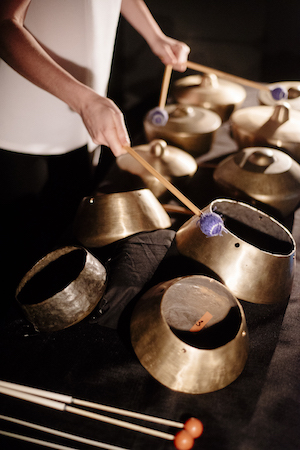Review: Louise Devenish, “music for percussion and electronics” ·
The Sewing Room, 15 May ·
Review by Jonathan W. Marshall ·
Louise Devenish is a WA based, virtuoso percussionist specialising in New Music — or if you prefer post-Romantic, post-Classical art music. On Tuesday, Perth’s Sewing Room saw the beginning of her national tour to promote the release of her album music for percussion and electronics, comprised of specially commissioned works by various Australian composers.
The recording, and hence the concert, represents the culmination of considerable work and refinement of this repertoire, much of which has been premiered in previous Perth concerts. Here, Devenish performed from memory, without written scores, an impressive feat which provided an unadorned setting for the performer’s very intense focus on her instruments and their nuances. For those in the know, the concert constituted a “greatest hits” of Devenish and of those with whom she has been working.
Not so effective was the use of visual projections from Ross Karre, which might work if the seating was elevated or raked. Instead, these were obscured by the less than ideal seating provided by the groovy but frankly unforgiving and unsympathetic setting of The Sewing Room.
Cat Hope’s “Tone Being”, for example, especially suffered compared to the 2016 performance in the acoustically insulated and focused State Theatre Centre Studio. Devenish attacked the gong with extremely measured and distinctly separated sonic gestures, punctuated by quite long gaps in which we contemplated with her various reverberations, low bass sounds in the speakers, or indeed almost nothing. The Sewing Room does not support this sort of listening well. Nevertheless, Devenish again demonstrated the particularity of her precise and almost (to my mind) thoughtfully neo-classical approach to her instruments. Austere and serious, her gestures were sparse, focused and concentrated.
The concert opened with Andrián Pertout’s “Exposiciones”, which pairs a recording of what sounds like a very old clock with Devenish live on glockenspiel. The clockwork thunks in the recording are irregular, gently building before snapping over. This counterpoints beautifully the scintillating materials provided by Devenish on glockenspiel. Pertout’s program notes make his rhythmic and temporal structure sound devilishly complex, but perhaps because I am a lover of funk, and, as he says, the thunks of the clock serve to mark “the downbeat” as in funk, it actually sounded like a relatively straightforward interdigitating of off-beats and asymmetric accents. In terms of sound quality, if not rhythmic patterning, it felt to me like a hyper-complexified version of Aphex Twin’s “Nannou” or perhaps even “On”.
Kate Moore’s “Coral Speak” is one of a suite she has written about the Great Barrier Reef. Chris Watson’s extraordinary and masterful field recordings have shown us that despite the apparently quiescent appearance of coral, it actually makes quite an active sequence of “snaps, crackles and pops”. Moore uses what sounds like processed chimes as the backing for her work, and while the electronics gradually morph into a pleasant enough background field, I cannot say I felt there was much connection between this inexactly moving around set of glassy/rocky sounds, versus the attractively measured rising and falling doubled strikes of the vibraphone. The best solution was to ignore these frankly annoying electronic elements altogether and focus on the live sound in the space.

The stand-out work in the concert was, therefore, Stuart James’s masterful work for electronics and “deconstructed gamelan” — that is to say gamelan gongs taken out of their frame and arranged in a non-sequential order. From small gestures using the upturned gongs as resonant bowls, to more layered, interactive sections where an irregular pulse and unresolved harmonics come into play, the five movements of the piece offered a diverse and meditative selection which also, at times, had urgency and power. Unexpectedly “small” or timbrally thin and high-pitched sections build and then evaporate in the face of sharp stick cracks, whilst a slightly watery and recognisably electronic or electroacoustic backing moves around within the performance space behind Devenish like a series of crunchy, mercury waterfalls. There is a lot to attend to here, both in terms of temporal accents and the relationship of sound textures.
James’s program notes offer an almost spiritualist interpretation of the piece, stating that, “The essence of sound is the breath, the compression and rarefaction of kinetic energy passing through the air.” I am not altogether convinced such concepts are clearly communicated by the music, or even that they could be. Nevertheless the piece has a rich, sonic gorgeousness, warmth and mystery which insists on dense contemplation. This might well be James’s first masterwork, beautifully brought into being by WA’s leading percussionist, Devenish.
Pictured top: Louise Devenish at The Sewing Room. Photo: Rachael Barrett.
Like what you're reading? Support Seesaw.






